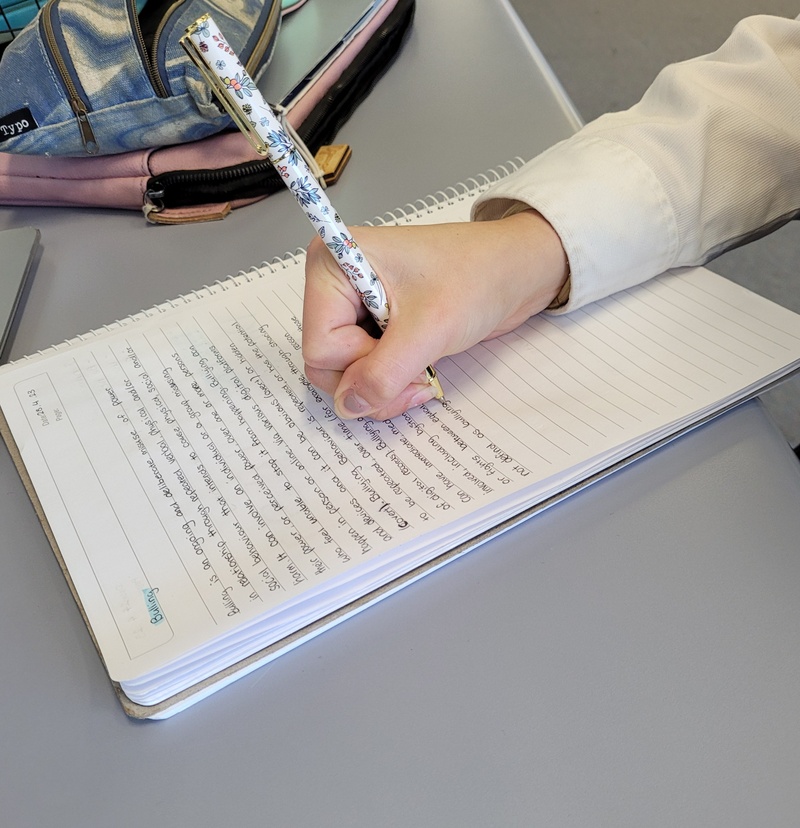StudySkills@TheLibrary
IMPROVING HANDWRITING
Most tests and examinations still require students to handwrite. To improve your handwriting, first consider how healthy you are in the four elements of legible handwriting: letter formation, sizing, alignment on the line and spacing between words. Then use the steps below to start to improve your handwriting:

Develop good handwriting
FIND THE BEST PEN FOR YOU: Experiment with different pens to see which is the easiest to write with and which one gives you the neatest handwriting. Use the same pen all the time.
GOOD GRIP: Hold the pen/pencil gently and do not grip too tightly or push too hard on the paper.
USE ARM MUSCLES: Always write with your forearm and shoulder NOT with your fingers or wrist. This way your strokes will flow much better. It may take you some time to retrain your arm and hand but be aware of these movements when you practise. The muscles in your forearm and shoulder tire less easily than your fingers.
BEGIN WITH LARGE STROKES: practice firstly on a whiteboard (or even tracing letters in the air) using large strokes until you feel comfortable with using your forearm and shoulder muscles. When you feel you have conquered this, it is time to begin practicing on paper. Keep using large strokes, gradually reducing them in size as your control of the muscles increases. Once you have accomplished this it is time to begin practicing in your exercise book forming normal sized letters.
POSTURE: Ensure you practice your handwriting skills at a desk or table. Sit up straight using a good chair.
RULED LINED BOOK: Buy a ruled exercise book for practice use. Always write on lined paper and take note of how you are writing and how your work looks on the page.
COPY STYLE: Look for an example of a handwriting style that you like and can use to copy from. Keep this in front of you at all times to inspire you towards improving your style.
INDIVIDUAL LETTERS: Begin with individual letters and practice writing at least one letter per day concentrating on the four elements of legible handwriting.
WHOLE WORDS: Once you have worked your way through individual letters in the alphabet practice writing whole words. Be aware of the flow from one letter to the next as well as spacing between words.
TEST SENTENCE: Choose a test sentence for yourself and write it at the top of your first practice page. Each week write this sentence at the top of a new page to check for improvement in your writing.
SPECIAL SENTENCE: Practice writing the sentence ‘the quick brown fox jumps over the lazy dog’ in small and capital letters. This sentence contains all the letters in the alphabet and gives you good overall practice of each letter.
WRITE SLOWLY TO START: Write slowly when practicing until you are happy with the quality of your handwriting. Then increase the speed.
REALISTIC GOALS: Don’t set impractical goals for improvement. Improvement will take time and is a matter for persistence – it all comes down to practice, practice, practice!
LOOK FOR OPPORTUNITIES TO WRITE: Try and handwrite whenever possible.
Once your handwriting style has improved, you can then focus on improving your speed. Doing this for just 5 minutes every day will really help you to improve your handwriting. If your cursive (running) writing is really bad, you may find it easier to learn to print really fast in exams rather than focus on improving your cursive style.
You can also try writing with a pen that is weighted on the end to build up the muscles in your hand used for writing. When you get to the exams take the weight off the end and feel the benefits of a lighter pen!